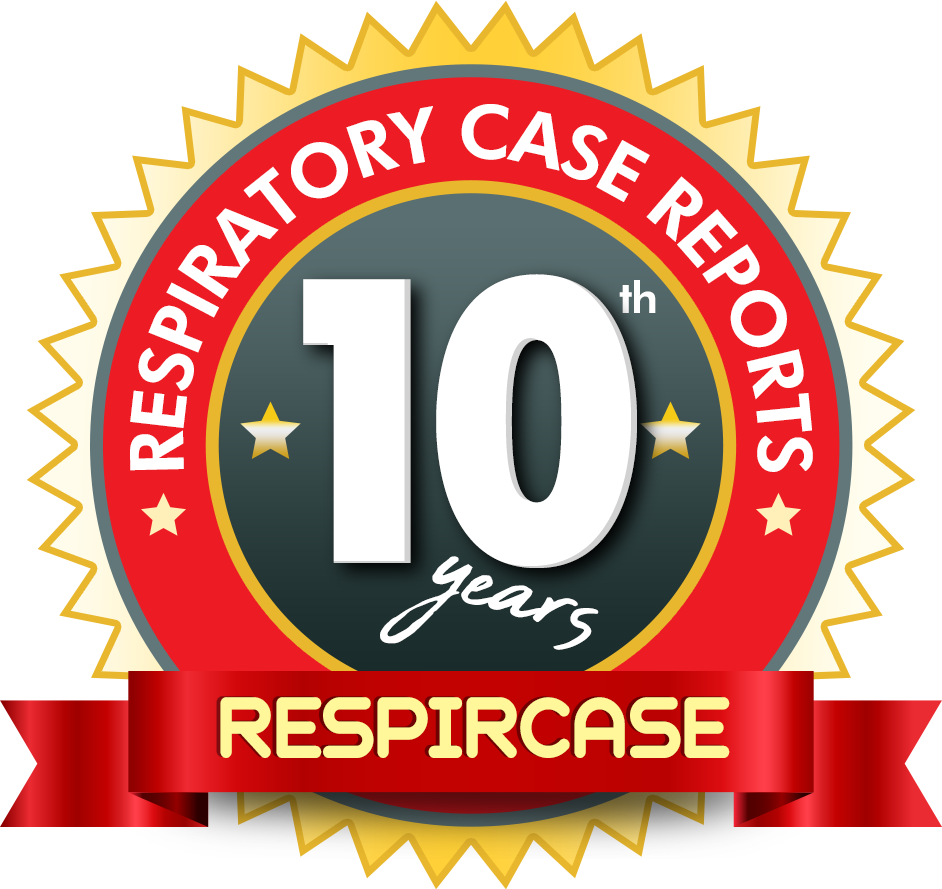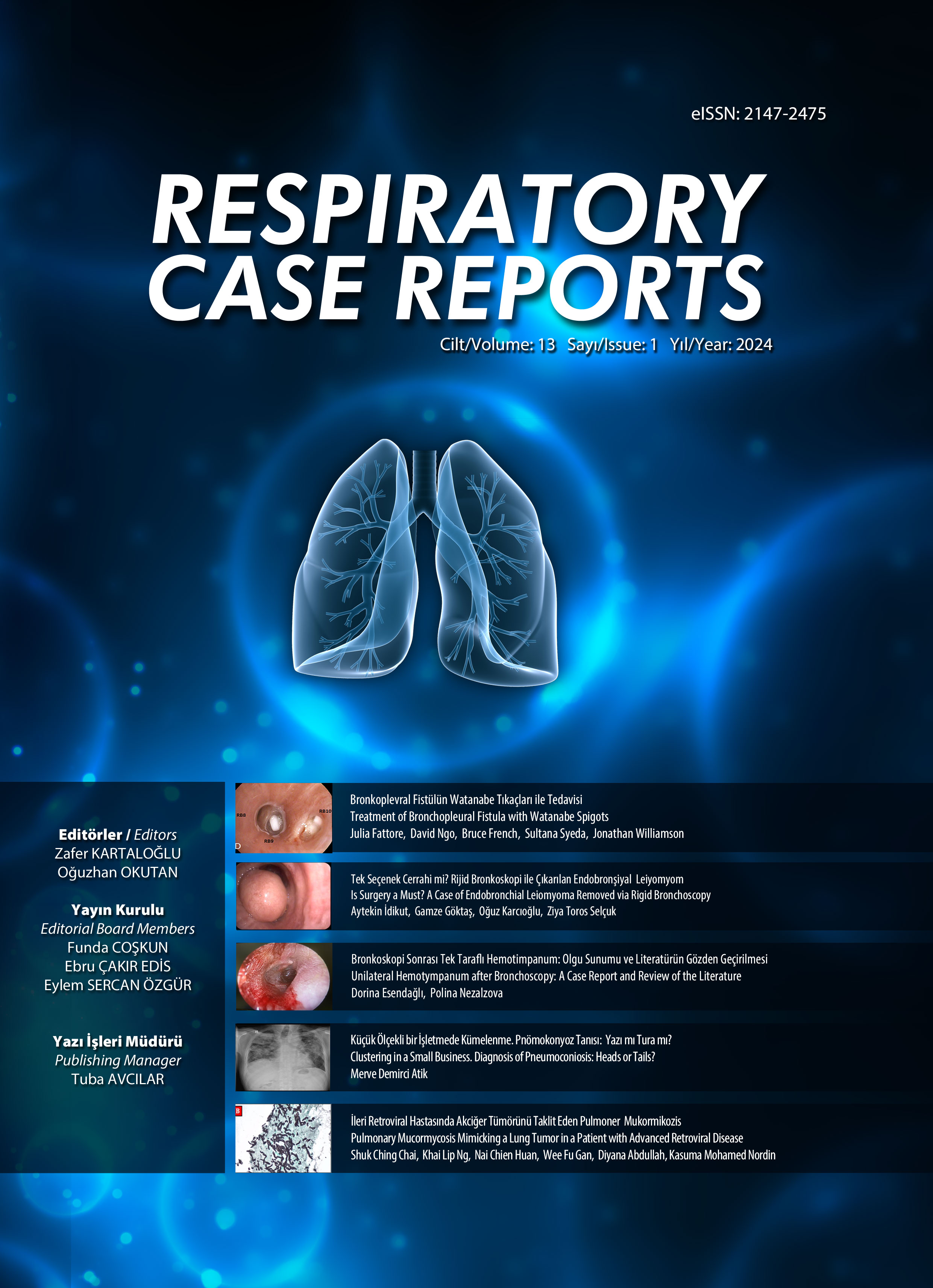e-ISSN 2147-2475


Volume: 8 Issue: 2 - June 2019
| CASE REPORT | |
| 1. | Interstitial Lung Disease in Systemic Lupus Erythematosus Gina Amanda, Prima Belia Fathana, Dianiati Kusumo Sutoyo doi: 10.5505/respircase.2019.03779 Pages 40 - 43 Nedeni bilinen interstisiyel akciğer hastalıklarının (İAH) etyolojilerinden birisi de bağ dokusu hastalıkları (BDH)'dır. Nedeni bilinen İAHya yol açana BDH arasında, sistemik skleroz, romatoid artrit, miks bağ dokusu hastalıkları ve Sjögren sendromu sıklıkla bulunmaktadır. Ancak sistemik lupus eritematozus (SLE) hastalarında bu durum nadiren görülür. SLEde İAH tanısı koymak zordur. Hava yolu hastalıkları, pulmoner infeksiyon ve vasküler anormallikler gibi diğer pulmoner tutulumlar öncelikle ekarte edilmelidir. SLE de ve diğer BDH olan İAH hastalarının tedavisinde kortikosteroidler ve diğer immünsüpressif ilaçlar kullanılır. Burada İAH olan iki SLE olgusu sunulmaktadır. Bir olguda SLEnin ilk bulgusu İAH idi, diğer olguda SLE tanısından sonra İAH görüldü. Connective tissue disease (CTD) is one of the etiologies of known-cause interstitial lung disease (ILD) that is frequently found with systemic sclerosis, rheumatoid arthritis, mixed-CTD and Sjӧgren syndrome, but which occurs rarely in systemic lupus erythematosus (SLE) patients. A diagnosis of ILD in SLE can be challenging, as the physician should first exclude other pulmonary involvements, including airway disorders, pulmonary infection and vascular abnormality. The management of ILD in SLE and other CTDs patients includes corticosteroid and other immunosuppressive medications. Here we report on two ILD in SLE cases: in one case, ILD was the first sign of SLE; and in the other, ILD appeared after the diagnosis of SLE had been established. |
| 2. | A Rare Presentation of Pulmonary Embolism: Cement Embolism after Vertebroplasty Özge Oral Tapan, Utku Tapan, Funda Dinç Elibol doi: 10.5505/respircase.2019.31549 Pages 44 - 48 Vertebroplasti ağrılı vertebra kırıklarının tedavisinde kullanılan minimal invaziv bir yöntemdir. Bu yöntemin nadir bir komplikasyonu olan sement embolisi genellikle asemptomatik seyreder ve tedavi gerektirmez. Semptomatik olduğu durumlarda ise antikoagulan tedavi veya cerrahi embolektomi uygulanması önerilmektedir. Travmaya sekonder torakal 12 vertebra fraktürü için vertebroplasti uygulandıktan 5 gün sonra göğüs ağrısı ve nefes darlığı ile başvuran ve antikoagulan tedavi verdiğimiz semente bağlı pulmoner emboli olgusunu sunmak istedik. Vertebroplasty is a minimally invasive method for the treatment of painful vertebrae fractures. Cement embolism, as a rare complication of this method, is usually asymptomatic and does not require treatment. Anticoagulant therapy or surgical embolectomy is recommended when symptomatic. We present here a case of pulmonary cement embolism who presented with chest pain and shortness of breath 5 days after vertebroplasty for a thoracic vertebrae fracture, and who had undergone anticoagulant treatment. |
| 3. | Tracheoesophageal Fistula Secondary to Tuberculosis: A Case Report Mutlu Onur Güçsav, Mine Gayaf, Nimet Aksel, Kenan Can Ceylan, Dursun Alizoroğlu doi: 10.5505/respircase.2019.96658 Pages 49 - 53 Trakeaözofageal fistül (TÖF) trakea ile özefagus arasında patolojik bir bağlantı olmasıdır. Enfeksiyon hastalıklarına sekonder gelişen TÖF çok nadir nedenlerdendir. Tüberküloz enfeksiyonu ise enfeksiyöz nedenler arasında en sık izlenenidir. Gastroenteroloji servisinde özefagus malignitesi ön tanısı ile tetkik edilen ve endoskopik biyopsi sonucu beklenen 78 yaşında erkek hasta nefes darlığı, sıvı gıda aldıktan sonra olan öksürük yakınması olması üzerine yapılan tetkiklerde aspirasyon pnömonisi tanısı aldı ve göğüs hastalıkları servisine nakil alındı. Bronkoskopisi yapıldı. TÖF ağzı görüldü. Bronş aspirasyonunda mycobacterium tuberculosis DNAsı saptandı. Endoskopik biyopsi sonucu granülamatöz reaksiyon olarak geldi. Hastaya tüberküloz nedenli TÖF tanısı konuldu. Anti-tüberküloz tedavisi başlanan hastaya trakeal Y stent takıldı. Makalemizi tüberkülozun nadir görülen bir TÖF nedeni olması ve nedeni bilinmeyen TÖFün operasyonu öncesinde tüberküloz bulaşına yönelik gerekli önlemlerin alınmasının önemini vurgulamak amacıyla sunuyoruz. A tracheoesophageal fistula (TEF) is a pathological connection between the trachea and esophagus. Infectious diseases rarely lead to TEF, and tuberculosis is the most common cause of TEF among all infectious causes. A 78-year-old male patient under examination for esophageal malignancy at the gastroenterology service, and who was expected to undergo an endoscopic biopsy, was diagnosed with aspiration pneumonia after complaints of dyspnea and coughing after liquid intake, and was transferred to chest diseases clinic. TEF was identified from a bronchoscopy. Mycobacterium tuberculosis DNA was isolated during a bronchial aspiration. An endoscopic biopsy, performed after esophageal malignancy was suspected, gave the result of a granulomatous reaction. The patient was diagnosed with tuberculosis-induced TEF. Anti-tuberculosis treatment was initiated, and a tracheal Y stent was fitted. In this article we present a rare case in which a TEF emerged secondary to tuberculosis, and suggest that tuberculosis may be a cause of TEF. It is advised that before starting invasive surgical TEF treatment, it is essential to take the necessary precautions. |
| 4. | A severe Case of Hypercalcemia due to Pulmonary Tuberculosis Reactivation Şule Gül, Ali Çetinkaya, Yağmur Başhan, Mehmet Atilla Uysal doi: 10.5505/respircase.2019.98598 Pages 54 - 57 3 yıl önce tüberküloz tedavisi alan 42 yaşında bayan hasta, polikliniğimize kas güçsüzlüğü şikayeti ile başvurdu. Akciğer grafisinde, sağ akciğerde yaygın kaviter ve nodüler infiltrasyon mevcuttu. Balgam aside dirençli boyaması (ARB) pozitif gelen hastaya reaktivasyon akciğer tüberkülozu tanısı kondu. Laboratuvar sonuçlarında ciddi hiperkalsemi saptanan hastaya, tüberküloz tedavisinin yanında hiperkalsemi tedavisi başlandı. Olgu nadir görülmesi nedeniyle literatür eşliğinde sunuldu. A 42-year-old female patient who was treated for pulmonary tuberculosis three years ago was admitted to our clinic with complaints of muscle weakness. On chest radiography, a diffuse cavitary lesion and nodular infiltration of the right lung was detected. Sputum acid-fast bacilli were positive, and the patient was diagnosed with pulmonary reactivation tuberculosis. Severe hypercalcemia was observed in the laboratory, and treatment for hypercalcemia was started alongside tuberculosis treatment. The case was presented to literature due to its rarity. |
| 5. | Tracheal Infection due to Corynebacterium striatum in a Female Patient: A Case Report Panagiota Xaplanteri, Efstratios N. Koletsis, Christos Prokakis, Iris Spiliopoulou, Dimitrios Dougenis, Fevronia Kolonitsiou doi: 10.5505/respircase.2019.23600 Pages 58 - 61 Nondifteriyal Corynebacteria insan cildi ve mukozalarında sıklıkla normal flora olarak kolonize olur. İmmün yetmezliği ya da kritik hastalığı olanlarda fırsatçı patojenler olarak ortaya çıkar. Corynebacterium striatum insanda, nadiren patojen olarak bildirilmiştir. Bu yazıda, daha önce hastahanenin Acil Servis'ine giderek artan dispne ve inspiratuvar wheezing bulgularıyla başvuran ve Yoğun Bakım Servisinde yatırılarak tedavi gören 62 yaşında beyaz kadın hasta sunulmuştur. Muayene, laboratuar ve görüntüleme bulguları, guatra bağlı eski trakeostomi sonrası gelişen enfeksiyonun neden olduğu Trakeal Stenoz ile uyumluydu. Kültürde çoklu antibiyotiklere dirençli C. striatum izole edildi. Hasta subtotal tiroidektomi, trakeal rezeksiyon ve tigecycline ile tedavi edildi. Ameliyat sonrası iyileşme, travmatik enfeksiyonun açık drenaj ve antibiyotiklerle tedavi edilmesi nedeniyle komplike oldu. Uzun süren iyileşme döneminde başkaca komplikasyonlar olmaksızın taburcu edildi. Nondiphtherial corynebacteria commonly colonize as normal flora on human skin and mucous membranes, and represent an emerging opportunistic pathogen for immunocompromised or critically ill patients. Corynebacterium striatum has seldom been reported as a human pathogen. Here we present the case of a 62-year-old Caucasian female patient who was previously hospitalized in the Intensive Care Unit, and who attended the emergency department with worsening dyspnea and inspiratory wheezing. The findings of a thorough examination, laboratory tests and imaging were consistent with tracheal stenosis, inflammation related to a previous tracheostomy and a submerged thyroid goiter. A multi-drug resistant C. striatum stain was isolated. The patient was treated with a subtotal thyroidectomy, tracheal resection and tigecycline. Postoperative recovery was complicated by a trauma infection treated with open drainage and antibiotics, and after a long recovery period, the patient was discharged home without further complications. |
| 6. | Pituitary Metastasis in Squamous Cell Lung Carcinoma Fatma Tokgoz Akyil, Emre Sedar SAYGILI, Belgit Talay, Mustafa Akyıl doi: 10.5505/respircase.2019.05945 Pages 62 - 66 Hipofiz metastazları asemptomatik olabilen, görüntülemelerde kolayca gözden kaçabilen ve çok nadir görülen metastazlardır. Bu olgu sunumunda, asemptomatik hipofiz metastazı saptanan akciğer skuamoz hücreli karsinomu tanısı konulan bir erkek hasta sunulmuştur. Yetmiş yaşında erkek hasta, genel durum bozukluğu nedeniyle çekilen toraks bilgisayarlı tomografide sağ alt lobda kitle tespit edilerek kliniğimize yönlendirildi. Bronkoskopide sağ ara bronşta izlenen lezyondan yapılan biyopsi skuamoz hücreli karsinom ile uyumluydu. Pozitron emisyon tomografi görüntülemede akciğer kitlesi, mediastinal lenfadenopatiler, karaciğer ve yaygın kemik metastazlarının yanında hipofiz sol kesiminde artmış metabolik aktivite izlendi. Hastanın hormon paneli hiperprolaktinemi ve hipogonadotropik hipogonadizm ile uyumluydu. Hipofiz manyetik rezonans görüntüleme infundibulum deviasyonu ve optik kiazma indentasyonu yapan 18x12 mm lezyon saptandı. Bu bulgularla hipofiz metastazı tanısı konulan hastaya radyoterapi planlandı fakat hasta tedavi alamayarak eksitus oldu. Akciğer kanserinde hipofiz bezi metastazı nadir de olsa görülebilir. Yalnız görüntüleme bulgularında saptanabilir veya takiplerde spesifik semptomlarla karşımıza çıkabilir. Metastases to the pituitary gland are extremely rare, and can be asymptomatic and easily overlooked in imaging. In this case report, a male patient diagnosed with a lung squamous cell carcinoma with asymptomatic pituitary metastasis is presented. A 70-year-old man was referred to our clinic with a right lower lobe mass identified in a thorax computed tomography. A bronchoscopic biopsy from the intermediate bronchus revealed a squamous cell carcinoma. Positron emission tomography imaging revealed increased metabolic activity in the lung mass; multiple mediastinal lymphadenopathies; liver and diffuse bone lesions along the left side of the pituitary gland. The patient's hormone panel was consistent with hyperprolactinemia and hypogonadotropic hypogonadism. Pituitary magnetic resonance imaging detected a deviation in the infundibulum and optic chiasm indentation with an 18 x 12 mm mass lesion. The patient was diagnosed with pituitary metastasis and radiotherapy was planned. The patient was unable to attend the follow-up and died within one month of diagnosis. Pituitary gland metastasis is extremely rare in lung cancer. It can be detected incidentally in imaging findings or from specific symptoms encountered during follow-up. |
| 7. | Lateral Thoracic Lung Herniation: A Rare Condition Erkan Akar, Miktat Arif Haberal, Özlem Şengören Dikiş doi: 10.5505/respircase.2019.27132 Pages 67 - 70 Akciğer herniasyonu, göğüs duvarındaki anormal bir açıklıktan akciğer dokusu ve plevranın toraks kavitesi dışına çıkması olarak tanımlanır. Burada, nadir görülen lateral akciğer hernili bir olguyu sunduk. Hasta acil ameliyata alınarak anterolateral torakotomi yapıldı. Kaburga ve akciğer parankim tamirinin ardından prostetik greft kullanmadan herni defekti kapatıldı. Hasta postoperatif beşinci günde şifa ile taburcu edildi. Cerrahinin zamanlaması konusunda tam bir fikir birliği bulunmamasına rağmen, künt toraks travmasına bağlı gelişen semptomatik akciğer hernilerinde, tanı konulduğu anda ameliyat yapılmasının uygun olduğunu düşünmekteyiz. Lung herniation is described as the protrusion of lung tissue and pleura out of the thoracic cavity through an abnormal gap in the chest wall. We present a case with a rare lateral lung herniation. The patient was taken for urgent surgery and an anterolateral thoracotomy was carried out. Pursuant to rib and lung parenchyma repair, the herniation defect was closed without a prosthetic graft. The patient was discharged on the postoperative fifth day with full recovery. Although there is a lack of consensus on the timing of surgery, we are of the opinion that in blunt thorax trauma-induced symptomatic lung hernias, operating on the patient is appropriate as soon as a diagnosis is established should be advised. |
| 8. | Spontaneous Pneumomediastinum Following to a Generalized Tonic Clonic Seizure Cenk Balta doi: 10.5505/respircase.2019.91886 Pages 71 - 73 Pnömomediastinum; mediastende serbest hava bulunmasıdır. Genellikle solunum veya sindirim sistemi organ perforasyonuna bağlıdır. Primer spontan pnömomediastinum periferik pulmoner alveol rüptürünün sebep olduğu nadir izlenen benign bir hastalıktır. Generalize tonik-klonik epileptik nöbet sonrası saptanan spontan pnömediastinum olgusunu sunacağız. Pneumomediastinum refers to the presence of air in the mediastinum. It is commonly occurs secondary to a perforation of respiratory or gastrointestinal system organs. Primary spontaneous pneumomediastinum is a rare and benign condition that can result from a peripheral pulmonary alveolar rupture. We present here a case of spontaneous pneumomediastinum that occurred following to a generalized tonic-clonic epileptic seizure. |
| 9. | Right Pulmonary Artery Agenesis and Right Pulmonary Hypoplasia, presenting with Bronchiolitis Symptoms Tayfun Kermenli, Aslı Serter doi: 10.5505/respircase.2019.49403 Pages 74 - 77 Unilateral pulmoner arter agenezisi (UPAA) tek taraflı pulmoner arterin yokluğu ile karakterize nadir görülen bir anomalidir. Fallot tetralojisi, aort koarktasyonu, atriyal septal defekt, turunkus arteriozus gibi kalp defektleri ile birlikte olabilir. Etyolojisi tam olarak aydınlatılamamıştır. Çocukluk çağında pulmoner hipertansiyon ile bulgu verebileceği gibi hastalar erişkin yaşa kadar da bulgu vermeden gelebilirler. Bronşiolit bulguları ile başvuran 33 yaşındaki kadın hasta erişkin yaşta tanı alması nedeniyle sunuldu. Tanı anında PA akciğer grafisi ve Toraks BTsinde sağ hipoplazik akciğer mevcuttu ve kardiyak ultrasonografide pulmoner hipertansiyon ile minimal triküspit yetmezlik tespit edildi. UPAA tanısında hastanın öyküsü, fizik muayene bulguları ve görüntüleme yöntemlerinden yararlanılır. Altın standart teknik pulmoner anjiografidir. Klinik semptomlar egzersiz intoleransı, hemoptizi ve tekrarlayan alt solunum yolu enfeksiyonlarını içerir. Unilateral pulmonary artery agenesis (UPAA) is a rare ailment, characterized by the absence of a unilateral pulmonary artery. UPAA may be associated with heart defects such as Tetralogy of Fallot, coarctation of the aorta, atrial septal defects and truncus arteriosus. The etiology has not been fully elucidated to date. Patients may present with signs of pulmonary hypertension during childhood, and symptoms of UPAA may not manifest until adulthood. A 33-year-old woman diagnosed at adulthood presented with symptoms of bronchiolitis. At the time of diagnosis, PA chest X-ray and Thorax CT images showed a right hypoplasic lung. Pulmonary hypertension and minimal tricuspid regurgitation were detected in a cardiac ultrasonography. For a diagnosis of UPAA, the patient's story, physical examination findings and imaging are used. The optimum imaging technique is pulmonary angiography. Clinical symptoms include exercise intolerance, hemoptysis and recurrent lower respiratory tract infections. |
| REVIEW ARTICLE | |
| 10. | Humoral Immunodeficiency and Infection Dilaver Taş, Ali İnal doi: 10.5505/respircase.2019.27167 Pages 78 - 85 İmmün yetmezlik görülen kişilerde, enfeksiyon sık olarak görülmekte ve bu enfeksiyonların tedavisi zor olabildiği gibi komplikasyonlara da yol açabilmektedir. İmmün yetmezlikler primer ve sekonder olarak karşımıza çıkabilir. Primer immün yetmezlikler, immün sistem elemanlarının fonksiyonlarını direkt olarak bozan genetik defektler sonunda ortaya çıkarken, sekonder immün yetmezlikler ise; yapısal olarak normal bir immün sisteme sahip bireylerin başta enfeksiyonlar olmak üzere ilaçlar, metabolik ve yapısal bozukluklar ve çeşitli çevresel faktörlerin etkisinde kalması ile ortaya çıkmaktadır. Bu derlemede immün yetmezlikler gözden geçirilecek, tanı ve tedavi yöntemleri anlatılacaktır. Infections are common in people with immunodeficiency, and these infections can be difficult to treat, and may lead to complications. Immunodeficiencies may be primary or secondary. Primary immunodeficiencies occur due to genetic defects, and directly impair the functions of the immune system, whereas secondary immunodeficiencies occur when individuals with a structurally normal immune system are affected by drugs, metabolic and structural disorders and various environmental factors, especially infections. In this review, immunodeficiencies will be discussed, and diagnosis and treatment methods will be put forward. |











